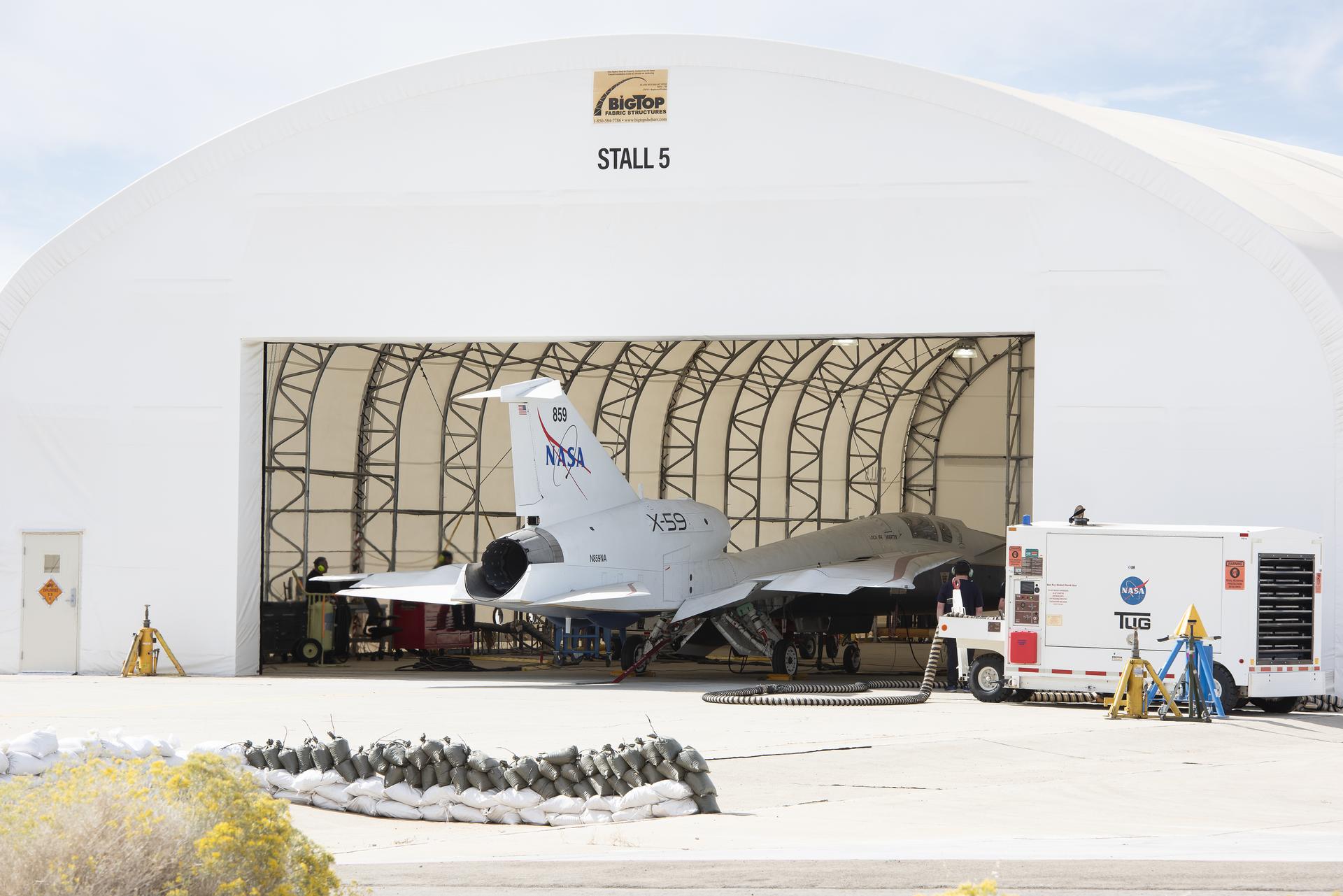NASA’s X-59 Mission Reaches a Milestone with Engine Tests
The NASA Quesst mission has achieved a notable milestone as it begins testing the engine that will power the experimental, quiet supersonic aircraft, the X-59. This marks a significant step forward in the mission’s goal to revolutionize supersonic flight.
The engine startup tests, initiated on October 30, are a crucial phase where the X-59 team ensures that the aircraft’s systems operate cohesively with its onboard engine. Previously, external power sources were used for testing. These engine tests are essential preparations for the next stages, ultimately leading to the experimental aircraft’s flight.
The X-59 team is conducting the engine startup tests in phases. In the initial phase, the engine was rotated at a low speed without ignition to check for leaks and ensure that all systems are communicating correctly. Following this, the team fueled the aircraft and tested the engine at low power to verify that it, along with other aircraft systems, operates smoothly without anomalies or leaks while the engine is running.
Jay Brandon, NASA’s chief engineer for the X-59, explained, “The first phase of the engine tests was essentially a warm-up to ensure everything was functioning correctly before starting it up. We then moved on to the first actual engine start. This took the engine out of the conservation mode it had been in since its installation on the aircraft. It was the first check to see that it worked correctly and that all related systems (hydraulics, electrical system, environmental control systems, etc.) appeared to function properly.”
The X-59 aims to produce a quieter sonic boom—more of a soft thump rather than the loud bang typically associated with breaking the sound barrier. This aircraft is central to NASA’s Quesst mission, which seeks to gather data on public perception of these quieter booms. The goal is to help inform and potentially lift existing bans on commercial supersonic flights over land.
The engine in question is a modified F414-GE-100, originally from an F-18 Super Hornet. It boasts nearly 10,000 kilograms (22,000 pounds) of thrust, enabling the X-59 to reach its desired cruising speed of Mach 1.4 (approximately 1,500 kilometers per hour or 925 miles per hour) at an altitude of nearly 17,000 meters (55,000 feet). Interestingly, the engine is mounted in an unconventional position above the aircraft, which helps reduce noise levels.
These engine tests are part of a comprehensive series of trials necessary to ensure flight safety and the mission’s success. Given the challenges in reaching this critical testing phase, the first flight of the X-59 is now scheduled for 2025. The technical team will continue to conduct critical ground tests and address any technical issues that arise with this one-of-a-kind experimental aircraft. The X-59 team will have a more precise flight date once these tests are successfully completed.
The tests are being conducted at Lockheed Martin’s Skunk Works facility in Palmdale, California. In later phases, the team will test the aircraft at high power with rapid acceleration changes, followed by a simulation of current flight conditions.
Paul Dees, NASA’s deputy propulsion chief for the X-59, expressed his excitement, stating, “The success of these runs will mark the culmination of the last eight years of my career. This is not the end of the excitement but a small step toward the beginning. It’s like the first note of a symphony, where years of teamwork behind the scenes are now put to the test to check that our efforts have been effective, and the notes will continue to play a harmonious song until the flight.”
After successfully starting the engine, the X-59 team will proceed to virtual iron bird tests. An iron bird is a structure used to test aircraft systems in a lab, simulating real flight conditions. During these tests, data will be fed into the aircraft under both normal and failure conditions. Next, the team will conduct a series of taxi tests, where the aircraft will be moved on the ground. These tests will be followed by final preparations for the maiden flight.
Good to Know: The Implications of the X-59 Mission
The X-59 mission holds significant implications for the future of air travel. By addressing the noise pollution caused by sonic booms, NASA hopes to pave the way for commercial supersonic flights over land. Current regulations prohibit such flights due to the disruptive noise, but if the X-59 can demonstrate a quieter supersonic experience, it might lead to changes in aviation policies.
Additionally, the technology and data gathered from the X-59 could influence the design of future aircraft, promoting more efficient and environmentally friendly designs. The success of the X-59 could also stimulate interest and investment in supersonic travel, potentially reducing flight times for long-distance travel.
While the journey to this point has been long and filled with challenges, each successful milestone brings us closer to a new era in aviation. The X-59 is not just an aircraft; it’s a symbol of innovation and progress in aeronautical engineering.
For more information on this groundbreaking development, you can read the original article on the NASA website [here](https://www.nasa.gov/aeronautics/x-59-fires-up-its-engine-for-first-time-on-its-way-to-takeoff/).
For more Information, Refer to this article.


































